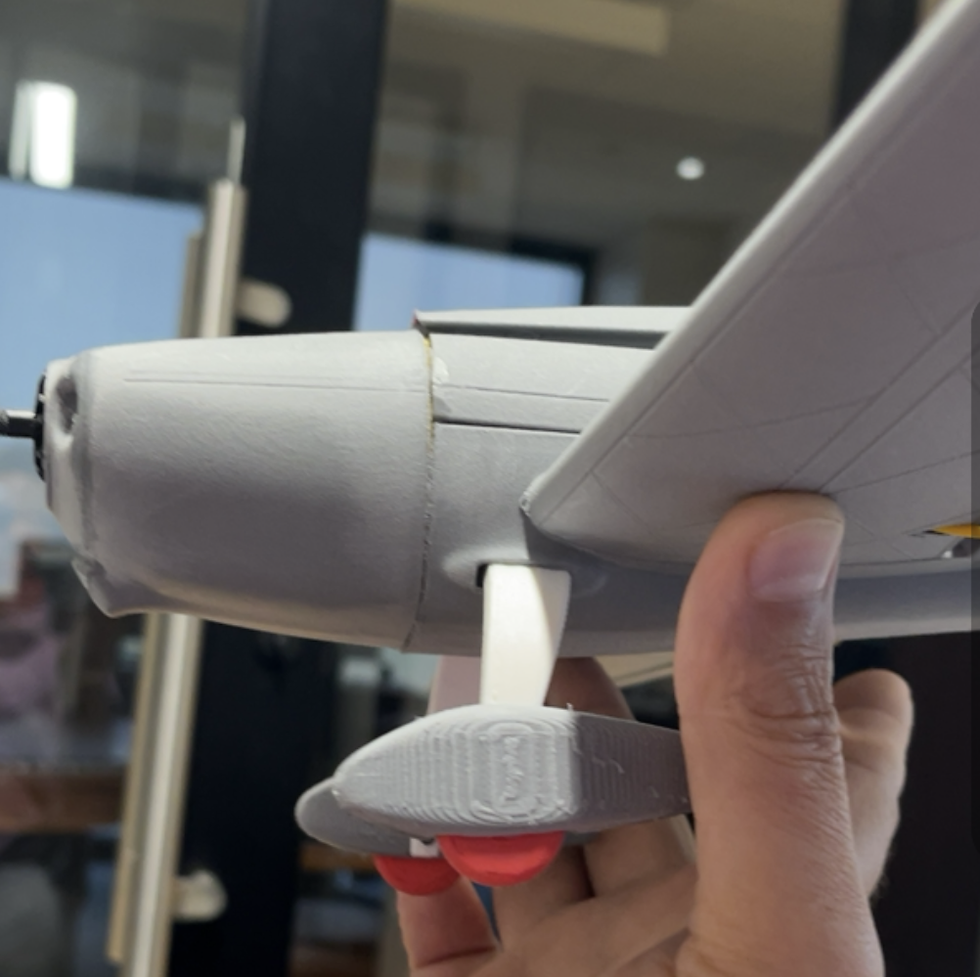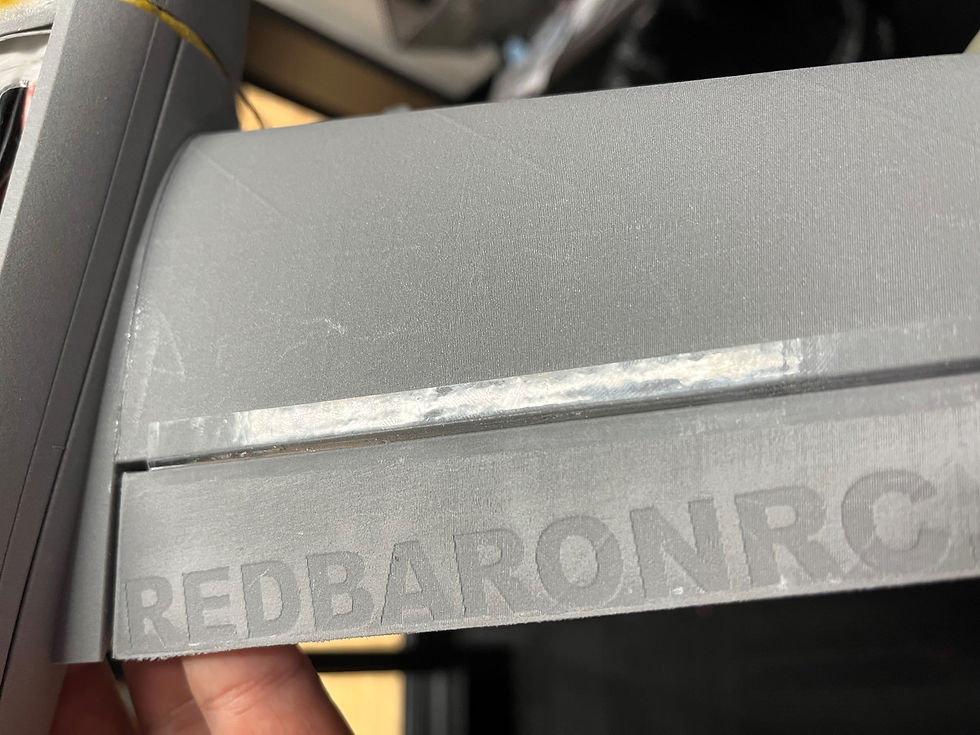Paint and Graphics for the Mini Extra 300.
- Robareeno

- Jul 27, 2022
- 6 min read
Updated: Aug 26, 2023
This section is intentionally last on the list because many of you may wish to ignore this section altogether. This is my list of reasons why:
Personally I think that lightweight PLA has one of the prettiest natural finishes out there, but as will all 3D printed things it is not perfect. If you are a prisoner of perfection like I tend to be, you may wish to take this to the next level.
You will likely not be able to keep this model under the 250 gram FAA no registration weight limit - Perhaps you care about this, or perhaps not. You could always just register the thing. Or not...... I don't see guys walking around in FAA hats ramp checking people at a flying field for a few years anyway. Nevertheless, the lighter this tiny model is, the better it will fly. Just saying.
If you are going to go through the trouble of painting this thing you might as well do it right, and this decision will add many hours of prep time to your model building time.
I haven't Talked you out of it? Let's proceed.
First off, I love the gray lightweight filament because it actually looks like primer. We just need to fill in the layer lines with some acceptable type of material and then sand, sand, sand. That traditionally would be a high fill primer, but let me show you a new Idea I've been working on.
I just happen to be a 3D printing junky if it is not already obvious. During one of my weaker moments I decided that I wanted to experiment with SLA printers so I purchased a little Phrozen Sonic Mini. It's all fine and good, but for the types of models I make it really isn't that useful and doesn't get turned on all that much. Let's not even get started on the mess and the stink! What is useful is the resin. I purchased a bottle of "PLA like" UV resin for this machine as well as a UV curing lamp.
Amazon Link for Resin - note you don't even need this kind of printer just paint on the resin.
To my surprise not only can I do this but I discovered this:
It adheres wonderfully to the lightweight PLA filament. Note I have not tried this yet on other filaments.
Unlike primer this is actually a plastic and it is adding significant strength to your model. Unlike a resin printed part, because we are putting it on so thin it is not brittle at all.
The resin is very sand able.
The resin can serve as your primer coat saving weight overall.
Because we are putting on the resin with a thin coat of a brush, it cures under a uv lamp almost instantly and is ready for paint or a brush immediately. I'm sure you could also easily spray this stuff but read my con's below before you start atomizing it into the air.
The UV lamp also has an added bonus of clearly showing you where the resin is in comparison to your filament underneath as the resin glows slightly under the lamp. This makes for great precision when sanding.
Now I finally have a use for spent resin that I don't wish to pour back in to the bottle and mix with any unused resin. I do have to deal with the stink but it's worth it.
There are a couple cons I need to mention:
The stuff stinks. Did I mention it stinks? It really stinks. It's also a bit messy and can get on anything and everything. Isopropyl alcohol is what is used to clean this up. They do make water soluble versions but I have as of yet not tried them.
This stinky stuff that glows under a UV light has got to be crazy toxic. Wear gloves when painting with it. Also I personally chose to use wet sandpaper only to keep the dust out of the air and my lungs. It also keeps the sandpaper going aggressively far longer anyway.
This stuff will not stick to super glue. What I mean is that if you have a shiny smear of super glue on your part this stuff has no way to create a mechanical bond to it and it will flake off. Be careful with the glue on your parts. Or spend some time sanding the shine off the glue so that this isn't a factor.
Remember that this is a plastic resin, not a paint. If you are sloppy with it and it wicks into a spot its not supposed to be (like for example the aileron pushrod holes for this model - don't ask me how I know this.) When you cure the part under the lamp you will have effectively fused parts together unintentionally. This stuff is so strong that I bet you could use it in lieu of glue to begin with to fuse the parts together on purpose. I'll get back to you on that one.
All Con's aside, this is going to be my go to finishing method moving forward. Take a close look at the image below of the canopy and the cowling. These were both finished in this manner and then simply shot with rattle can Krylon enamel.

Pointers on sanding:
If you can visibly see an imperfection and you have to ask yourself if it will be visible in the finished model the answer is yes keep sanding and filling.
If you can no longer see the imperfection, close your eyes and lightly run your finger over the area. Your fingers can actually pick up surface defects better than your eyes. If you feel anything that tells you where your finger is in relation to the defect you were working on then you need to keep sanding.
Let the part dry occasionally and look at the area you have sanded. High spots will be dull from the sanding and low spots that are not leveled out yet will be very shiny.
Use the uv light to take a peek occasionally at what you are sanding. The glowing nature of the resin under the light can really highlight areas with imperfections.
I use 180 grit to shape, then fairly quickly move up to 320 grit wet or dry paper.
I created these little sanding blocks that you can super glue a small round circle to. They are easier to deal with than just holding the paper plus they have a flat surface with helps leveling spots out. Download for free here just follow the directions.
Pointers on painting:
Find a spot that is well ventilated, and free of any dust or dirt or bugs that will want to crawl into your pretty finish.
plan where you will paint first. I find all the hard areas that may be difficult to get paint into and lightly shoot them first. Then I let the paint flash for several minutes to prevent runs.
light coats are better because we are building an airplane not a submarine. They also dry faster so you can recoat quicker - and less bugs get a chance to get their irritating little legs stuck in the finish if you are having to do this outside. Heavy coats really don't cover better or fix flaws that you should have sanded out before you started painting.
plan on where you will place the model while it dries. I try to make a way to hand the model from a string so no part has to touch anything.
If you have to re shoot any parts after you have let the model dry let the model cure for several days before attempting a recoat. Otherwise the solvent from the new paint will soften the uncured paint below causing it to wrinkle up and expand. The effect is called busting the paint. You are in for a lot of sanding if that happens.
Graphics and Decals:
Check back often as we are working on vector based graphics sets that can be inkjet printed on to decal transfer paper. It's a great way to get a really professional scale finish on your model. These sheets run on any standard inkjet printer. Once printed and allowed to dry you simply coat the decal with a spray of clear spray paint. Once that has dried the decal is now waterproof. simply cut our decal out and immerse in water to activate the waterslide glue. Slide the decal in place and gently blot out excess water from behind the decal. Once dried you are all done.
Conclusion: That is it for the paint and graphics! Check the main blog here for anything you may have missed, but at this point it's time to go fly! Feel free to reach out to us with any questions. We will attempt to clarify the construction blog including your input as much as possible. Also please check out or new community forum. Feel free to post pics, ask questions, or help others.


Hi,
Thanks so much for the very useful information I'm never happy with my models after I paint them and I never thought of using resin but now I will thanks to you.
Also, I don't see the link to download the sanding blocks could you please send me the link you're welcome to send via email Kayhussani@Gmail.com. Thank you so much for your help and time